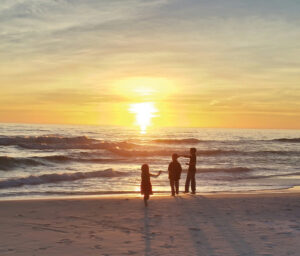 By Chris Balzer, ECES
By Chris Balzer, ECES
When planning your next beach day, take some extra time and enjoy the beach ECES style (Emerald Coast Energy Solutions). Of course, we like the traditional beach things; sitting by the water, watching the waves curl ever so slightly, looking for that pod of dolphin fins, listening for and watching low fly bys or watching a sea turtle grab breakfast. You know, the ordinary beach stuff. Going to the beach here is anything but ordinary; we are blessed to have air and sea shows on a regular basis almost every time we go to the beach. Here are a few more things to think about on your next beach day.
 One of the first things you should know is what the heat index is. The heat index is the “feels like” temperature to the body when relative humidity is combined with the air temperature. It could be 93° with a “feels like” 102°. Heat indexes of 103° or higher are considered dangerous; use caution when planning beach days or outings with a high heat index.
One of the first things you should know is what the heat index is. The heat index is the “feels like” temperature to the body when relative humidity is combined with the air temperature. It could be 93° with a “feels like” 102°. Heat indexes of 103° or higher are considered dangerous; use caution when planning beach days or outings with a high heat index.
While checking the weather forecast and heat index, be sure to check the UV forecast. Checking UV (ultraviolet radiation) should become as much of a habit as checking the weather. UV forecasts include many factors, so don’t assume cloud cover or lower temperatures mean low UV. Anyone who has gotten a sunburn on a cloudy day understands. Checking UV is particularly important if you plan to spend several hours outside and even more so at the beach where UV radiation can be increased by reflecting off our white sands and water.
Wear reef safe sunscreen. The best way to protect yourself from UV radiation is by staying in the shade or wearing protective clothing. Another way is slather on reef safe sunscreen. Be sure to check the back of the sunscreen bottle. Some sunscreens contain chemicals that can harm marine life including corals, fish and even dolphins.
Get to know the sand between your toes. We have some of the whitest beaches in the world and all thanks to the Appalachian Mountains and the Apalachicola River. 20,000 years ago, when the world temperatures began warming after the last Ice Age, large volumes of water were carried by rivers to the world’s oceans. The Apalachicola River carried small quartz particles to the Gulf of Mexico and continues today. These unique quartz particles created our shorelines and beautiful white beaches.
Share the shore. Our beaches are great, but they aren’t ours—we’re all just visitors. Snorkeling, diving and even sitting, one can experience a whole world coexisting at the beach. Share the shore and take the pledge that you will find out how to keep yourself and the marine animals around you safe. As tempting as it is, keep your distance from marine life and leave that shell souvenir behind. Some shells play a vital role in our beach ecosystem and taking some washed up items can actually be illegal. If you are looking for that perfect souvenir, try an airbrushed t-shirt reading, “My friends visited the beach and all I got was this lousy t-shirt.”
The next time you plan to go to the beach, do it ECES style: Check the heat index and UV forecast, use reef safe sunscreen, enjoy the sand, share the shore and Beat the Heat!
Chris Balzer is Founder and President of Emerald Coast Energy Solutions (ECES) a Smile Provider Company. We provide smiles to our customers after installing our high energy efficient products, increasing comfort and lowering energy bills. For more information on how to save this summer and become energy efficient, schedule an inspection by calling (850) 588-2870, visit www.trusteces.com or email wecare@trusteces.com and Beat the Heat.





























































